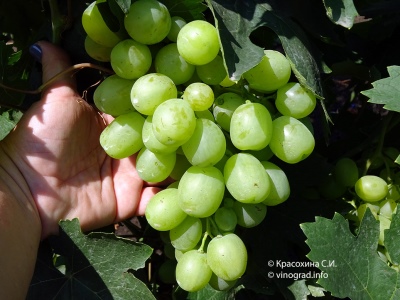
- Authors: VNIIViV them. Potapenko, Novocherkassk
- Appointment: dining room
- Berry color: White
- Taste: harmonious
- Ripening period: very early
- Frost resistance, ° C: -23
- Bunch weight, g: 598
- Flower type: bisexual
- Tasting assessment, points: 8,6
- Peeling: No
Table grape varieties are distinguished by their yield. This is what gardeners value most. The Aisar grape variety is just that. In this article, we will consider the characteristics of the variety, ripening time, yield, taste, as well as frost resistance and storage time.
Breeding history
The Aisar grape variety is relatively young; it was bred at the A. Potapenko in the city of Novocherkassk. Richelieu and Talisman grape varieties were taken for the parental pair.
Description
The bushes of the Aisar grapes are small, of medium height. The vine grows up to 4 m, semi-spreading. The color of the vine is dark brown below, the shoots are light green. The leaves are large, with 3 lobes, but also wedge-shaped. Straight cut and large jagged edges are present. The anterior surface of the leaf is glossy, the posterior surface is matte, with barely perceptible pubescence.
The vine ripens well. Many gardeners note that Aisar grapes share well with cuttings.
Ripening period
In terms of ripening, the variety belongs to the early maturing. Full ripening of the fruits occurs at the beginning of August. In the northern regions, the period increases until the first days of September.
Bunches
The bunches ripen large and weighty, on average 598 g. The shape is conical, elongated. The berries in the clusters are located tightly to each other. No peeling.
Berries
Fruits are oval in shape, slightly oblong, large. By weight 10-12 g, some ripen and 20 g. In color, the fruits vary from white to golden with a slight pink bloom. The pulp is juicy, firm and crunchy. The peel is thin, when used, it is not felt at all.
Taste
Taste qualities are excellent, increased sweetness is noted. The ratio of sugar is 232 g / dm3, acidity is 4 g / dm3. This indicator indicates that there is absolutely no sourness in the fruits.
Yield
Up to 40 kg of grapes can be removed from mature bushes. The figure varies from proper bush grooming as well as weather conditions.


Growing features
Grapes do not like too moist soil. Although the fruits will not crack from excess water, it can still affect the root system. Therefore, it is necessary to choose a loose, loamy soil, and a place away from water bodies. For more confidence, a drainage system is made during planting.
Aisar grapes can be propagated both by the root method and by cuttings. Both methods guarantee a good survival rate of new seedlings.
It is worth observing the watering and feeding regime.
Before planting seedlings, it is necessary to think over the trellis system and the planting method. It can be a trench or a hole.
Landing
Saplings can be planted both in spring and autumn. First, prepare the ground. It can be dug up and fertilized in advance.This method is suitable for trenching. If planted in holes, it is not worth digging up the selected area.
It is necessary to dig holes 0.8 m deep and 0.5 m wide. At this time, a trellis system is installed along the way. Pebbles or broken brick are poured into the bottom of the hole, this will act as drainage. Then a layer of fertile soil is poured out along with minerals containing nitrogen. After the seedling is lowered. The branch is gradually covered up, the earth around is tamped. Then it is poured abundantly with water.

Pollination
Aisar grapes have flowers of both sexes, so no additional pollination is required.
Pruning
Pruning is carried out in several stages. In the spring, dry and broken branches are cut, as well as those that have not left after winter. In the summer, the vines are pruned a little, the branches that have begun to grow in the wrong direction are removed, and the non-fruiting shoots. And also the foliage at the bottom and at the top is cut, especially the one that closes the bunches too much.
In the fall, cut off vines that have been bearing fruit for more than 3 years, as well as those that have been damaged by the disease. Fruiting vines are shortened by 5-7 eyes. Autumn pruning is done after the crop has been harvested and before the first frost.



Frost resistance and the need for shelter
The grapes have good frost resistance - 23 degrees. But, according to gardeners, the vine does not withstand such low temperatures. Therefore, the bushes must be covered for the winter. The branches are removed from the trellises, carefully twisted and lowered onto the board. Do not allow contact with the ground. The vines can be covered with a dry layer of earth or covered with spruce branches, then everything is covered with agrofibre or roofing material.

Diseases and pests
The grapes are susceptible to the fungal disease oidium, in order to avoid the spread of the disease, the bushes must be sprayed 3 times per season. Preparations that contain fungicides are suitable.
It is worth spraying for the first time after the snow melts, during the growing season, and 3 times, when the clusters have already formed, and the berry has begun to fill with color.
Many gardeners note that Aisar grapes are not susceptible to attacks from wasps.

If the grapes are exposed to any disease or insect, this is always reflected in its appearance.
Storage
The grapes have good shelf life - from 1.5 months.











































































